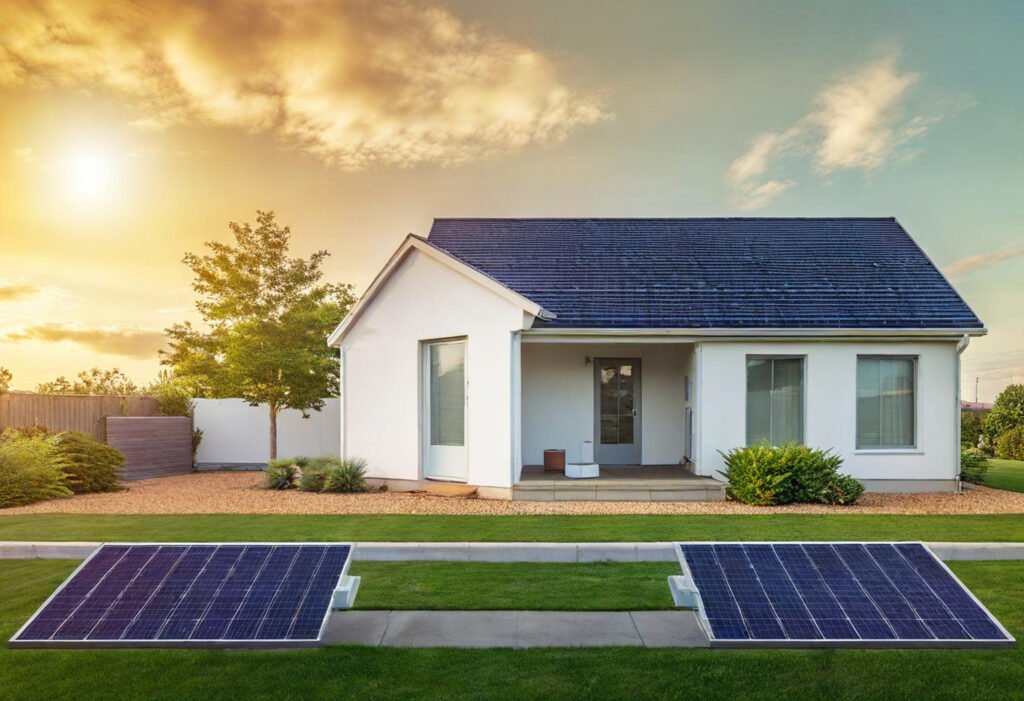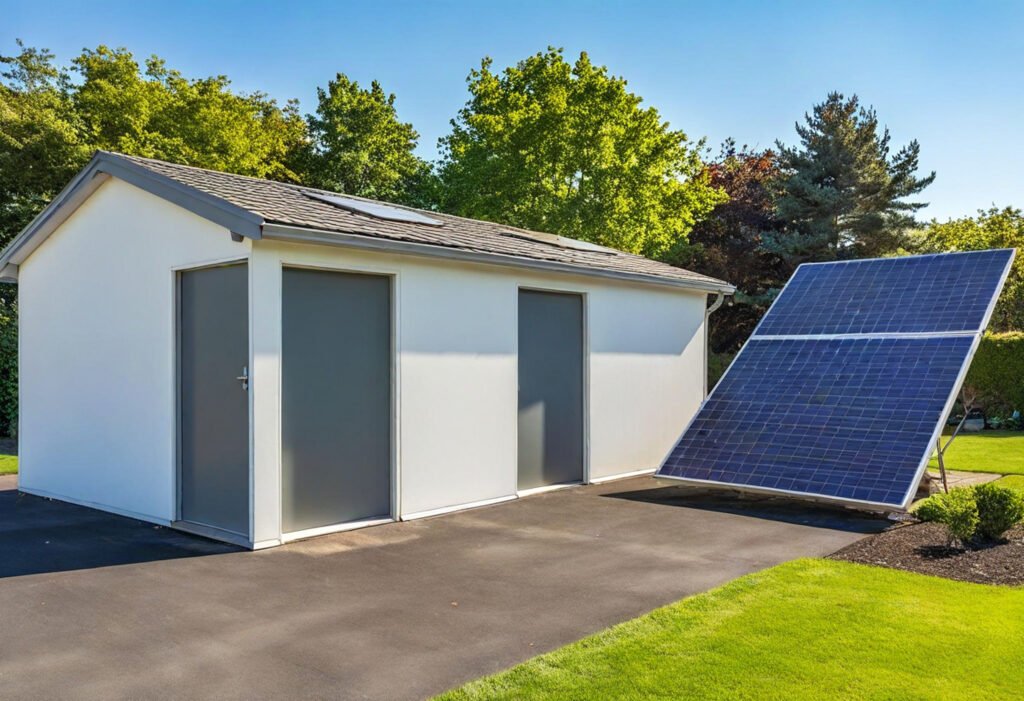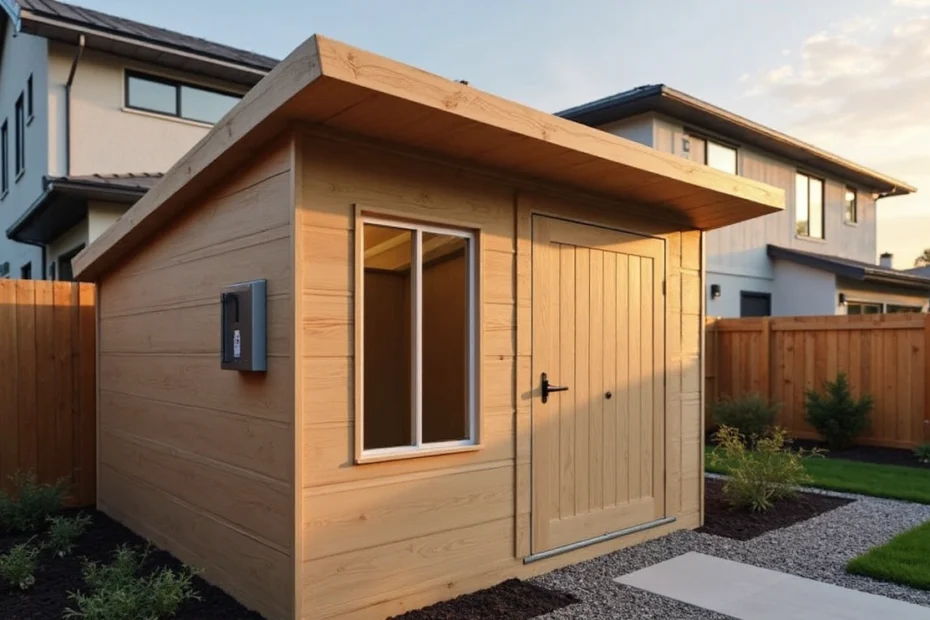Planning a modern house with solar panels? You might be missing something significant. Most homeowners focus on their main building and forget that sheds can also be solar-ready. Anyone with experience in contracting services knows that changes made later can be expensive. Small investments now often lead to big savings down the road.
Solar panel design makes perfect sense for all home structures, including your shed. The best solar home design needs plenty of southern exposure without vents and chimneys blocking the way. East and west-facing solar-ready panels work well too, but they’ll produce about 80% of what south-facing panels generate. A shed’s solar power system needs just a few panels. This makes the PV system affordable and easy to install. Each panel weighs between 40-50 pounds, so proper preparation helps maintain structural integrity. More homeowners want to reduce their carbon footprint, and eco-friendly shed designs offer a smart solution.
Why Make Your Shed Solar-Ready
Making your shed solar-ready brings benefits that go beyond powering tools and lights. Here’s why getting your shed ready for solar makes sense when planning your complete solar home design.
Save money on future installations
Building your shed with solar in mind cuts costs compared to updating it later. You’ll avoid expensive changes by installing conduit, pre-wiring, and adding structural support during construction. The good news is that governments offer financial incentives for solar adoption. These rebates and tax credits can cut your upfront costs by a lot. Homeowners might qualify for a 30% federal tax credit, plus extra state and local incentives based on where they live.
Improve aesthetics with hidden wiring
A smartly designed solar system makes your property look better, not worse. Modern solar installations look great thanks to clever design choices. You can pick all-black panels without aluminum frames that blend naturally with your roof. When you hide components during construction, everything looks cleaner than trying to conceal wiring afterward. Smart solar system planning can make your roof look better by covering less attractive features.
Boost energy efficiency and output
Solar-ready sheds help create a more efficient system. Regular outbuildings use power from the main grid, which drives up electricity costs and carbon footprints. Solar-powered structures give you clean, renewable energy for everything from simple lighting to workshop tools. The sun provides free electricity and cuts your power bills. Your shed won’t depend on utility companies during price changes or blackouts.
Increase property value and resale appeal
The best part? Homes with solar features sell for more money. Research shows solar-equipped properties sell for about 4.1% more than similar homes without solar. A $450,000 home could gain $13,500 to $18,000 in value. These homes sell 20% faster than those without solar. Rising energy costs make buyers value lower utility bills from the start.
Designing the Shed Roof for Solar Panels

Your solar panel installation’s success depends on the perfect shed roof design. Good planning now will help you avoid problems later. Let’s head over to everything you need to know about creating an ideal solar-ready shed roof.
Choose the right roof orientation and tilt
South-facing roofs in the northern hemisphere catch the most sunlight during the day, which makes them best for solar panel efficiency. East or west-facing roofs work too, but they only produce about 80-93% of what south-facing installations generate. The tilt angle plays a vital role – most places in the continental U.S. work best between 15-40 degrees. This angle helps maximize solar output and determines how weather affects your system.
Avoid obstructions like vents and chimneys
A clean roof surface without obstacles gives you more space for solar panels. Your usable area shrinks with plumbing vents, chimneys, skylights, and gables. Try to group all needed roof equipment on north-facing sections whenever you can. Watch out for shade from nearby trees, buildings, or structures that could block sunlight during peak hours.
Use uniform rectangular roof faces
Rectangular roof designs offer the biggest continuous space for solar panels. Roofs with fewer hips and valleys make installations look better and easier to complete. Complex designs not only make solar mounting harder but also drive up construction costs and create ventilation and insulation challenges.
Think about snow shedding and weather effects
Roof pitch matters even more in areas that get snow. Panels set at steeper angles (around 40 degrees) shed snow better than flatter ones. Snow usually clears within a day or two after falling. If you live where heavy snow is common, mounting systems that let you tilt solar panels work great – you’ll see better snow shedding at 30-35 degree angles.
Essential Solar-Ready Shed Components
The work to be done to make your shed solar-ready needs several key components installed correctly during construction. Your preparation will determine how smoothly future solar installations go on your modern house with solar panels.
Install conduit from the attic to the electrical panel
Your solar system’s wiring needs proper conduit installation as its pathway. You should install a 1.5-inch conduit from the electrical room to the attic at a minimum. The conduit should be built from metal, rigid PVC, liquid-tight flex, or metallic tubing – preferably in a straight line. Larger sheds might need bigger conduit sizes. The small extra cost now helps avoid modifications that can get pricey later. The conduit must extend above attic insulation and should have a pull string so wires can be installed easily.
Plan for electrical panel space and upgrades
Save about 2′ x 3′ of wall space near your electrical panel for future solar equipment. Inverters and control systems that convert solar energy into usable power need this space. Your panel’s busbar rating should be higher than the main breaker rating to maximize potential solar capacity. Here’s a simple rule: pick a 150A panel for a 100A main breaker, and go with a 200A panel if you have a 150A breaker.
Use solar-specific junction boxes
Solar junction boxes protect vital connections in your solar panel design for your home. These weatherproof enclosures shield against environmental damage and make installation easier. Today’s solar junction boxes handle up to 1500V DC and can manage 25A current capacity. They work reliably even in extreme temperatures from -55°C to 200°C.
Account for attic access or vaulted ceilings
Regular solar-ready preparations usually need attic access for cable routing. Vaulted ceilings need extra planning beyond normal conduit installation. These designs should have roof-level junction boxes with interior connections installed during construction.
Select compatible roofing materials
Your choice of roofing material significantly affects solar panel performance. Standing seam metal roofs work best with solar panels and need minimal penetrations. Asphalt shingles also work well but require drilling and flashing for secure mounting. Metal roofs last 40-75+ years, making them excellent investments for solar installations.
Solar Home Design Integration Tips

Solar system integration goes beyond individual structures. Your shed’s solar setup should work as part of a unified energy ecosystem with your main residence. This approach will give you maximum efficiency and utility throughout your property.
Match the shed’s solar design with the main house system
The harmony between your shed and house solar systems depends on your connection choice. A grid-tied system gives you simplicity without batteries and eliminates problems during cloudy periods with zero maintenance. You can wire directly to your main panel and share energy if your shed sits close to home, though distance increases wiring costs. A small, independent off-grid system for your shed might be your best option. This setup works on its own while complementing your home’s solar design.
Plan for future battery storage or EV charging
Smart design leaves room for new technologies. Your solar-ready shed needs dedicated spaces where future battery systems can store extra daytime energy for night use. The best spots for EV charging infrastructure are garages and carports that get plenty of sunlight. Your EV charging prep should include:
- Energy requirement calculations based on your driving patterns
- Extra system capacity to handle vehicle charging
- Inverters that can manage EV charging loads
Coordinate with solar-ready panels and inverters
Compatible components create a smooth operation. High-efficiency monocrystalline panels work great for limited roof space. The right inverter will convert DC electricity from panels into AC power that your home and EV charger can use. Modern charge controllers keep your batteries safe by regulating electrical current. Quality solar kits come with 25-year guarantees – they might last longer than your shed!
Expert advice can make a big difference. A solar company can help you pick the perfect system size by looking at your energy bills and site conditions. This expertise will help your shed’s solar system work perfectly with your modern house with solar panels.
Conclusion
A solar-ready shed makes a smart investment that will pay off for years. This piece shows how smart planning at the time of construction saves money compared to modernizing later. Your property’s energy independence gets a boost, and its market value could jump by up to 4.1%.
The best way forward combines solid structural design with key parts like right-sized conduit, dedicated electrical panel space, and weather-resistant junction boxes. The right roof orientation helps maximize energy production. Clean design and hidden wiring keep everything looking great.
Most people don’t think about their sheds for solar installations, but these buildings are perfect for expanding renewable energy capacity. Your shed’s solar system can naturally work with your main house setup to create a complete energy ecosystem on your property.
Don’t treat your shed as an afterthought – call it a key piece of your modern solar home design from day one. A small upfront investment in solar-ready features gives you flexibility down the road. You might want battery storage, EV charging, or just reliable power for tools and equipment.
A solar-ready shed brings your vision of a green, energy-efficient property to life. Taking these steps now will give your property clean, renewable energy benefits for decades.
